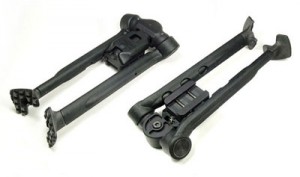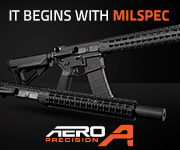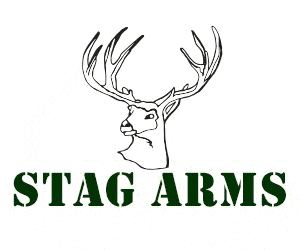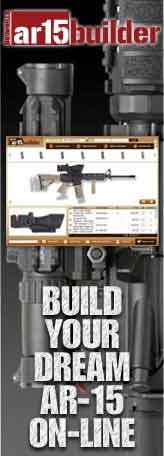The Tango Down Advanced Combat Bipod is designed specifically for the M16/M4 weapon families. Attached directly to the MIL-STD 1913 MWS (SOPMOD) rail system, no separate adapters necessary.
Bipod body – The clamp body and center portion are forged from 7075-T6 aluminum with Type III hard anodizing. The center portion has two pivots, to which the legs are attached. It will fit on any MIL-STD 1913 rail, using a clamp on the base that is secured by two stainless, black finish screws. An allen wrench or screwdriver can be used to install or remove the ACB. A black stainless button on the outside of each pivot releases and engages a sealed, pre-lubricated stainless steel locking mechanism, which allows the bipod legs to rotate 90° from stowed to deployed. It is locked in both positions and can only be released by touching the button. The center portion rotates for traversing and allows about 40° of angle. The whole bipod body can cant 15°. Urethane bushings keep the bipod center-favored while allowing it to cant on uneven ground.
Legs – The legs are made up of two pieces – the inner and outer legs. The outer legs house the locking mechanism and button, and have 3 holes/detents which provide 3 height adjustments. The outer legs are made of a proprietary glass-reinforced nylon and are much tougher than they look (I was concerned early on in the design stage when I saw the inner legs, but tried to snap one and I couldn’t. The ACB-4 has exceeded Army drop-test requirements). The inner legs are made of carbon-fiber reinforced nylon, and slide in and out of the outer legs. At the top of the inner leg is a button, which fits into the detents in the outer legs. The inner legs are extended by simply pulling them out. In order to shorten them, the button must be depressed and the leg slid in, where the button will engage the next detent. The feet are large to prevent sinking in sand and aggressively checkered for a good grip. When stowed, the bipod legs are locked along the rail system, fitting neatly between the lower and side rails.













